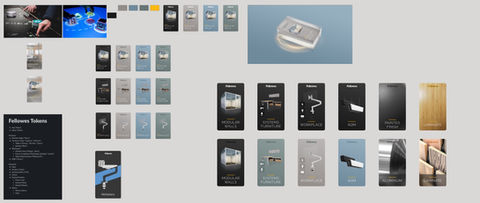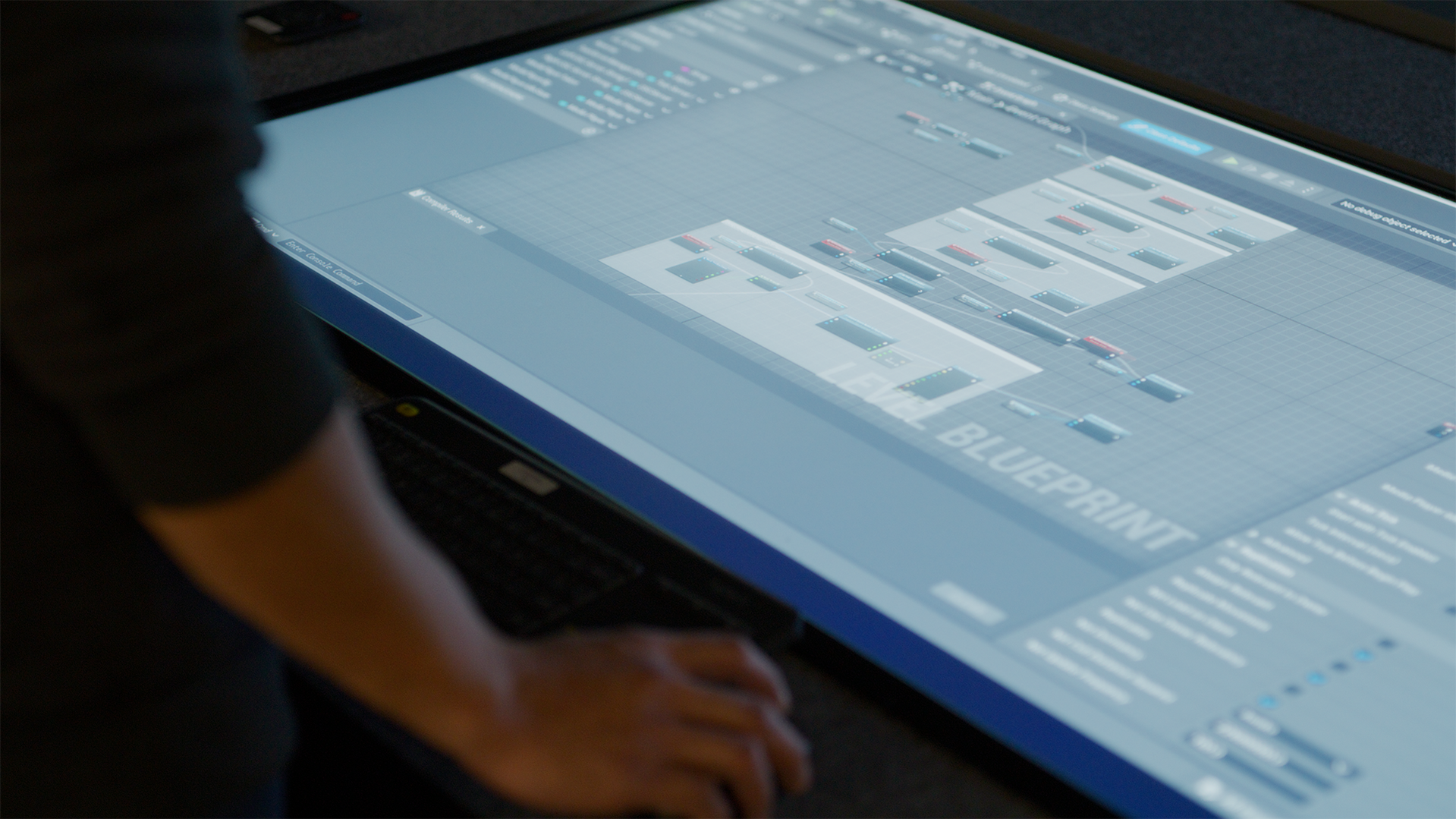
CLIENT
Fellowes Brands
FELLOWES
PORTRAY
Our solution was a groundbreaking experiential installation in Fellowes' Chicago showroom. This immersive tool transformed the conceptualization phase, enabling real-time visualization and collaboration, thus reducing weeks of negotiations to moments of creative convergence.
Our Solution
The initial stages of interior design projects were fraught with friction. Translating visionary ideas into tangible plans was a slow, iterative process, choked by the limitations of traditional CAD software and prolonged discussions.
Insight
Unraveling the core issue led us through a labyrinth of conversations within the Fellowes ecosystem. Amidst this complex web of needs and perspectives emerged a crucial insight: the genesis of a project was where we could make the most impact.
Challenge

Our goal was to create a tool around which the client, designer, and sales rep alike could have a meaningful conversation about design with layouts, products, options, materials, and finishes - all configurable in the blink of an eye and usable by the clients themselves.

PORTRAY was built from the ground up in the Unreal Engine to leverage its state-of-the-art real-time ray tracing capabilities for unparalleled and instantaneous realism, circumventing the need for lengthy CAD renders.
With a 27-foot-wide curved projection screen controlled by a pair of 55-inch touchscreen tables, users can create, customize, and iterate design concepts for interior spaces utilizing a novel but intuitive blend of physical and digital controls.

PORTRAY is an immersive interactive tool built for Fellowes Brands, a global leader in workspace solutions, as the flagship experience in their new Fulton Market showroom in Chicago.
Overview

One of the things that sticks out to me is the curiosity that the team had to learn our business. They were constantly either asking questions or on the journey, trying to understand our industry, our products, and how they could best add value to the process. And that was a hallmark."
John Fellowes
CEO & President of Fellowes Brands
"
When such a project is in these preliminary pre-specification stages, there's often a great deal of back-and-forth between designers, reps, and clients as each change has to be taken back to CAD software to be reconsidered and re-rendered (a process often taking weeks or even months). During this phase, functional needs, budgets, and timelines all have to dovetail with visual ideas to create a cohesive design.
And that’s where PORTRAY comes in.
Of course, each group had their own set of issues and challenges in their workflow; however, as their stories wove together, it became clear to us that the best place for a visualizer experience for Fellowes and for the industry at large, was in the early stages of a project when it’s still forming in the minds of the clients and designers.
When Fellowes came to us looking for a central digital experience in their new showroom, it kicked off an intensive period of research and explorations with their team, partners, clients, and industry veterans to determine the type of experience that could best suit them.

Research
UX & Design
We settled on the projector-and-touch-table format for Fellowes' system early on. After which the challenge became taking the vast catalog of furniture, workspace accessories, modular walls, materials, and finishes offered by Fellowes and create a design system that would comfortably integrate into the showroom.
This software needed to be approachable by any user - easy to comprehend and intuitive - without any of the complicated overhead of CAD software, but with enough freedom and flexibility to enable users to explore unique design ideas through a multitude of possible configurations.


These became our "Typicals," a set of hand-picked pre-configurations of furniture for each room space within PORTRAY with which the user could populate their space immediately and then customize it to suit their needs - set of building blocks instead of simply a blank canvas.
Our goal of making a system that was both quick and intuitive meant that we pored over the common configurations and layouts of Fellowes' modular walls and furniture to find the most popular arrangements so that we could provide users with a starting point.
Vignettes & Typicals
UX & Design



With a physical sample in hand, the user is then able to match it to virtual materials on the table - each surface and trim piece able to individually be included or omitted when the material is applied to the products in the virtual scene.
Having chosen walls, furniture, and workspace accessories for their project, a user would be able to peruse a showcase of physical material samples for inspiration and take these samples back to the PORTRAY room to apply them to their virtual space.
Materials & Finishes
UX & Design


By using an acrylic "puck" on one of the touchscreen tables, the user is able to pivot their view and move around the environment simply by sliding and rotating the device around on the screen - an easy interaction that quickly became a favorite among users.
Even inveterate software developers and gamers struggle in traversing a virtual environment at times, and solutions as outlandish as using a physical video game controller were considered for navigating our digital space - but in the end, a simple and elegant answer emerged.
Camera Token
UX & Design

The challenges faced in the development of this project are too numerous to list, as the combinations of technologies in play were anything but off-the-shelf and required a great deal of finagling for interoperability.
From building an ultrawide curved projection screen and stitching together multiple projector images, to the communication between the interactive table displays and the real-time virtual environment, every piece of this project required bespoke engineering.
Development



Then, there was the matter of communication between the software powering the table and the software driving the projector visuals; all of which had to be run through a server that would also serve as a Content Management System for Fellowes, and create and maintain a personalized microsite for each user updated in real-time for their remote colleagues to follow along with.
We chose the Unreal Engine as the basis for the visuals in the project as its ability to to create unparalleled realism was a must for us, but it presented a challenge in that simply getting the table hardware and Unreal to communicate required a great deal of custom software solutioning, which, to the best of our knowledge, had never been done before.
Communication
Development

The furniture within the rooms is able to be rearranged and reorganized to suit the needs of an individual space, or combined in an open floorplan, all while having accessories such as monitor arms or lighting options added, removed, and modified and every finish and material able to be altered.
Working from raw CAD drawings, we created the 3D assets and software by which the architectural walls surrounding a room could be made to any size, joined together in intricate configurations with customized glass and paneling materials, accent trim pieces, door styles, and hardware selections.
Content
Development

PORTRAY made its debut at the renowned industry convention NeoCon, and was immediately met with overwhelming praise - with many parties claiming they would fly their clients to Chicago in order to save weeks of back-and-forth.
PORTRAY is a living experience, evolving as Fellowes evolves and providing an anchor point for Fellowes, their clients, dealers, and designers to continue collaborating long into the future.
Reception

PORTRAY not only helped us see our vision come to life, but it gave us confidence that our rep and her team understood our vision as well."
Rahvy R. Murray
State Farm Insurance
"

































